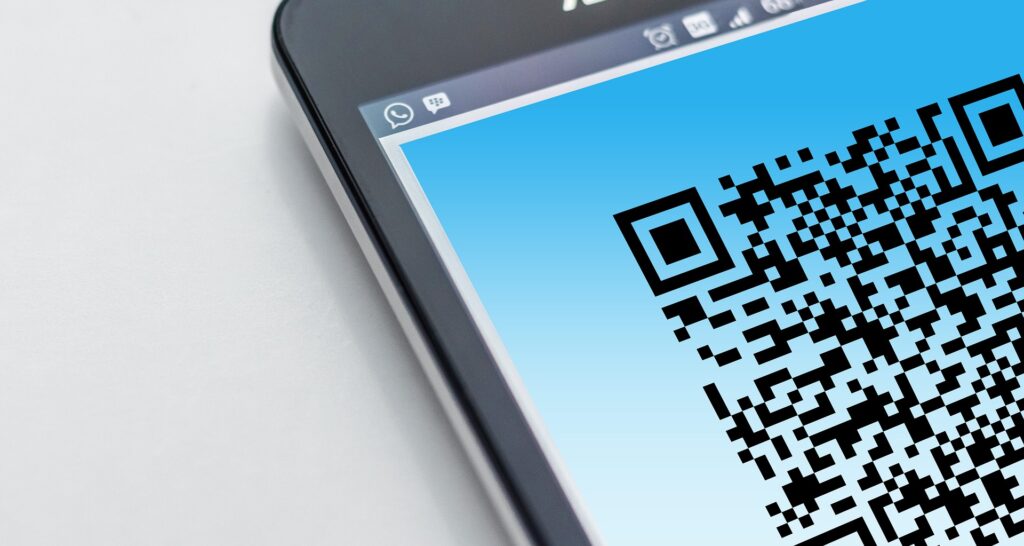You can scan them off your TV to purchase items featured on “The Today Show,” pull up a restaurant’s menu, or check-in when you’re having your tires changed. Just when QR Codes were about to go the way of the dodo, the pandemic resurrected them as a useful tool for customers to connect with brands. Read on to learn more about how these quick-response codes were invented, why they’re making a comeback, and how you can best utilize them in your business.
History of QR Codes
QR Codes started with a much simpler, and now everyday technology: the barcode. In the 1960s, inventors in Japan created barcodes that could be read by an optical sensor to transmit information to a computer instantaneously. The marketplace quickly adopted the technology, but soon found a shortfall. Barcodes could only hold 20 alphanumeric characters of information.
Denso Wave Incorporated, developers of barcode readers, adopted the challenge to create a more complex, two-dimensional code that could also read kanji (Japanese writing using Chinese characters.) Enter Masahiro Hara, who successfully created a code that incorporated a black-and-white pattern with a ratio that rarely occurred on printed matter. Hara’s code could be read from any angle of scanning, and it incorporated four standardized encoding modes (numeric, alphanumeric, byte/binary, and kanji.) In 1994, Denso officially released the QR Code.
The auto industry quickly adopted QR Codes to manage workflows. The codes soon expanded to other industries as they made food, pharmaceutical items, and even contact lenses traceable and transparent. Denso Wave made the specifications for QR Codes free, which paved the way to public adoption. In 2002, QR Codes hit their first wave of popularity when mobile phone technology allowed the codes to be read quickly and connect customers to the web. Over the years, the ciphers fell out of favor because people struggled to understand how to scan a code, and website or app connections aren’t always seamless leading people to become frustrated with the process.
QR Codes’ Renaissance
When the pandemic fell over the global marketplace in 2020, QR Codes quickly regained their spot on the marketing tool leaderboard. It’s easy to see why they’re appealing during this time: contactless and easy to use. They’re simpler to use these days because QR code readers are native to smartphone cameras; they don’t require a separate app to use. Apple first incorporated this functionality into the iPhone in 2017 and other manufacturers quickly followed suit.
QR Codes have boomed during the pandemic. According to Statista, 45 percent of respondents said they’d used a QR Code in the three months prior to the June 2021 survey. Additionally, 59 percent of survey participants said they saw QR Codes becoming permanent fixtures in their lives.
Uses of QR Codes
The following are a few locations and uses businesses have already found for QR Codes for marketing and customer service:
· Business cards to direct users to resumes or Google Reviews
· Table display to take users to a menu for a restaurant or catering company
· Postcard mailing to enter a contest to win prizes
· Front door sticker to check-in for appointments
· Residential or commercial for-sale signs to take users on a virtual property tour
· Temporary tattoo to connect users to a social media account
· Sign in a bar or restaurant bathroom to connect to a taxi service
· Museum signage to give more information
· TV advertisements to take users to web pages for more information
Incorporating QR Codes into Your Business
There are a variety of free, basic QR Code generators online. The generators begin to charge fees if you want to incorporate additional features, such as facilitating payments or customizing your design. Custom designs allow you to incorporate your logo, brand colors, or manipulate the traditionally square codes into different shapes. This can be a valuable way to draw attention to your codes or to change them based on different campaigns.
Some generators also allow you to track your QR Codes’ scanning history. For marketing, this is especially valuable because you can track ROI and user engagement on your campaigns. However, if you’re using the codes only for payments, you may not need this feature.
Square, Shopify, and PayPal allow you to generate code through their services for contactless payments. According to The Financial Brand, 57 percent of consumers expected to continue using contactless payments post-pandemic, so it’s wise to arrange a contactless payment method for your clients regardless of your industry.
How LuckyTamm Digital Marketing Can Help
LuckyTamm stays up to date with the latest digital marketing trends and can advise you on how to best incorporate QR Codes for marketing and customer service. If you’d like to know more, we offer free consultations. Connect with us, today!

